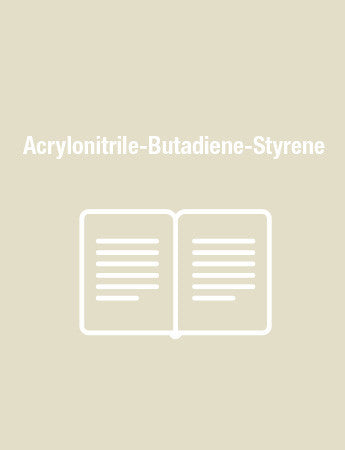Polymers selected for this edition of the Handbook of Polymers include all primary polymeric materials used by the plastics and other branches of the chemical industry and specialty polymers used in the electronics, pharmaceutical, medical, and space fields. Extensive information is included on biopolymers.
The data included in the Handbook of Polymers come from open literature (published articles, conference papers, and books), literature available from manufacturers of various grades of polymers, plastics, and finished products, and patent literature. The above sources were searched, including the most recent literature. It can be seen from the references that a large portion of the data comes from information published in 2011-2021. This underscores one of this undertaking's significant goals: to provide readers with the most up-to-date information.
Frequently, data from different sources vary in a broad range, and they have to be reconciled. In such cases, values closest to their average and values based on testing of the most current grades of materials are selected to provide readers with information that is characteristic of currently available products, focusing on the potential use of data in solving practical problems. In this process of verification, many older data were rejected unless recently conducted studies have confirmed them.
The presentation of data for all polymers is based on a consistent pattern of data arrangement, although, depending on data availability, only data fields that contain actual values are included for each polymer. The entire scope of the data is divided into sections to make data comparison and search easy.
The data are organized into the following sections:
• General (Common name, IUPAC name, ACS name, Acronym, CAS number, EC number, RTECS number, Linear formula)
• History (Person to discover, Date, Details)
• Synthesis (Monomer(s) structure, Monomer(s) CAS number(s), Monomer(s) molecular weight(s), Monomer(s) expected purity(ies), Monomer ratio, Degree of substitution, Formulation example, Method of synthesis, Temperature of polymerization, Time of polymerization, Pressure of polymerization, Catalyst, Yield, Activation energy of polymerization, Free enthalpy of formation, Heat of polymerization, Initiation rate constant, Propagation rate constant, Termination rate constant, Chain transfer rate constant, Inhibition rate constant, Polymerization rate constant, Method of polymer separation, Typical impurities, Typical concentration of residual monomer, Number average molecular weight, Mn, Mass average molecular weight, Mw, Polydispersity, Mw/Mn, Polymerization degree, Molar volume at 298K, Molar volume at the melting point, Van der Waals volume, Radius of gyration, End-to-end distance of unperturbed polymer chain, Degree of branching, Type of branching, Chain-end groups)
• Structure (Crystallinity, Crystalline structure, Cell type (lattice), Cell dimensions, Unit cell angles, Number of chains per unit cell, Crystallite size, Spacing between crystallites, Polymorphs, Tacticity, Cis content, Chain conformation, Entanglement molecular weight, Lamellae thickness, Heat of crystallization, Rapid crystallization temperature, Avrami constants, k/n)
• Commercial polymers (Some manufacturers, Trade names, Composition information)
• Physical properties (Density, Bulk density, Color, Refractive index, Birefringence, Molar polarizability, Transmittance, Haze, Gloss, Odor, Melting temperature, Softening point, Decomposition temperature, Fusion temperature, Thermal expansion coefficient, Thermal conductivity, Glass transition temperature, Specific heat capacity, Heat of fusion, Calorific value, Maximum service temperature, Long term service temperature, Temperature index (50% tensile strength loss after 20,000 h/5000 h), Heat deflection temperature at 0.45 MPa, Heat deflection temperature at 1.8 MPa, Vicat temperature VST/A/50, Vicat temperature VST/B/50, Start of thermal degradation, Enthalpy, Acceptor number, Donor number, Hansen solubility parameters, dD, dP, dH, Molar volume, Hildebrand solubility parameter, Surface tension, Dielectric constant at 100 Hz/1 MHz, Dielectric loss factor at 1 kHz, Relative permittivity at 100 Hz, Relative permittivity at 1 MHz, Dissipation factor at 100 Hz, Dissipation factor at 1 MHz, Volume resistivity, Surface resistivity, Electric strength K20/P50, d=0.60.8 mm, Comparative tracking index, CTI, test liquid A, Comparative tracking index, CTIM, test liquid B, Arc resistance, Power factor, Coefficient of friction, Permeability to nitrogen, Permeability to oxygen, Permeability to water vapor, Diffusion coefficient of nitrogen, Diffusion coefficient of oxygen, Diffusion coefficient of water vapor, Contact angle of water, Surface free energy, Speed of sound, Acoustic impedance, Attenuation)
• Mechanical properties (Tensile strength, Tensile modulus, Tensile stress at yield, Tensile creep modulus, 1000 h, elongation 0.5 max, Elongation, Tensile yield strain, Flexural strength, Flexural modulus, Elastic modulus, Compressive strength, Young's modulus, Tear strength, Charpy impact strength, Charpy impact strength, notched, Izod impact strength, Izod impact strength, notched, Shear strength, Tenacity, Abrasion resistance, Adhesive bond strength, Poisson's ratio, Compression set, Shore A hardness, Shore D hardness, Rockwell hardness, Ball indention hardness at 358 N/30 S, Shrinkage, Brittleness temperature, Viscosity number, Intrinsic viscosity, Mooney viscosity, Melt viscosity, shear rate=1000 s-1, Melt volume flow rate, Melt index, Water absorption, Moisture absorption)
• Chemical resistance (Acid dilute/concentrated, Alcohols, Alkalis, Aliphatic hydrocarbons, Aromatic hydrocarbons, Esters, Greases & oils, Halogenated hydrocarbons, Ketones, Theta solvent, Good solvent, Non-solvent)
• Flammability (Flammability according to UL-standard; thickness 1.6/0.8 mm, Ignition temperature, Autoignition temperature, Limiting oxygen index, Heat release, NBS smoke chamber, Burning rate (Flame spread rate), Char, Heat of combustion, Volatile products of combustion)
• Weather stability (Spectral sensitivity, Activation wavelengths, Excitation wavelengths, Emission wavelengths, Activation energy of photoxidation, Depth of UV penetration, Important initiators and accelerators, Products of degradation, Stabilizers)
• Biodegradation (Typical biodegradants, Stabilizers)
• Toxicity (NFPA: Health, Flammability, Reactivity rating, Carcinogenic effect, Mutagenic effect, Teratogenic effect, Reproductive toxicity, TLV, ACGIH, NIOSH, MAK/TRK, OSHA, Acceptable daily intake, Oral rat, LD50, Skin rabbit, LD50)
• Environmental impact (Aquatic toxicity, Daphnia magna, LC50, 48 h, Aquatic toxicity, Bluegill sunfish, LC50, 48 h, Aquatic toxicity, Fathead minnow, LC50, 48 h, Aquatic toxicity, Rainbow trout, LC50, 48 h, Mean degradation half-life, Toxic products of degradation, Biological oxygen demand, BOD5, Chemical oxygen demand, Theoretical oxygen demand, Cradle to grave non-renewable energy use)
• Processing (Typical processing methods, Preprocess drying: temperature/time/residual moisture, Processing temperature, Processing pressure, Process time, Additives used in final products, Applications, Outstanding properties)
• Blends (Suitable polymers, Compatibilizers)
• Analysis (FTIR (wavenumber-assignment), Raman (wavenumber-assignment), NMR (chemical shifts), x-ray diffraction peaks)
It can be anticipated from the above breakdown of information that the Handbook of Polymers contains information on all essential data used in practical applications, research, and legislation, providing that such data are available for a particular material. In total, over 230 different types of data were searched for each individual polymer. The last number does not include special fields that might be added to characterize specialty polymers' performance in their applications.
We hope that our thorough search of data will be useful and that users of this book will skillfully apply the data to benefit their research and applications.
The contents, scope, treatment of the data (comparison of data from different sources and their qualification), and novelty of the data qualifies the book to be found on the desk of anyone working with polymeric materials.
Polymeric materials used in electronics require special sets of data for various applications. These materials are the most frequently compounded plastics, containing suitable additives to achieve the required set of properties. Those who are interested in these materials should also consider the recently published Handbook of Polymers in Electronics.
Handbook of Polymers, 3rd Edition




